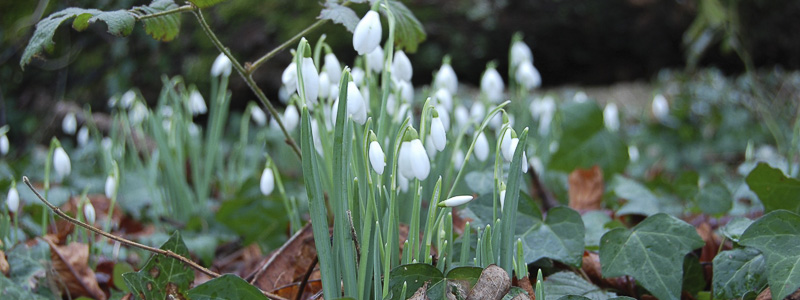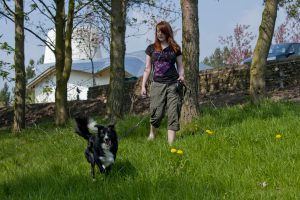By Kevin Lafferty Access, Health & Recreation Policy Advisor
(in Volume 28)
Can we use our urban woodlands to promote outdoor activity and physical fitness for both dogs and their owners? In 2016 Forestry Commission Scotland, The Kennel Club and Paths for All commissioned some research in communities near urban woodlands in Glasgow. The findings will be of interest to policy makers and outdoor recreation providers, academics, land managers and vets.
The high prevalence of obesity is a major issue facing most developed countries, and the UK is no exception. Being obese increases the risk of developing conditions requiring expensive, long-term management, such as type II diabetes and cardiovascular disease. Similar concerns extend to canine health, with recent evidence suggesting almost two thirds of dogs could be overweight and experience the associated health risks and poor health outcomes.
Therefore, finding out how to motivate dog owners to walk more with their dogs has the potential to provide significant health gains for both humans and their canine companions.
The study explored the motivations, beliefs and behaviours that people have about walking their dogs and investigated what might encourage less active people to access local woodlands to benefit their own health and that of their dogs. The research took place at three woodland sites in Glasgow: Boden Boo, near to Erskine; Rawyards in Airdrie; and Bishop Loch in Easterhouse. We surveyed 300 less active dog walkers who live close to one of the sites (100 at each site) and ran six focus groups with local dog owners.
The survey collected information about awareness of the local woodland site, beliefs about woodland walks, preferences for facilities, and the activities that dog owners may like to attend at their local woodland. In the focus groups we collected in-depth feedback on how dogs influence the exercise that people do, and what type of environment makes an attractive place to regularly walk with a dog. We also conducted five interviews with local vets, and one with a veterinary nurse to explore their views on an “ideal” walk and the advice they give dog owners.
Our results showed fewer than half of survey respondents were aware of their local woodland site. Those who had visited their local woodland site reported that having an interesting place to walk, car parking, having bins clearly marked to accept dog waste and having places to sit down all make a woodland walk more enjoyable. Broken glass and other rubbish on the site, dog owners not picking up after their dog and concerns about antisocial behaviour were the main issues people felt made walking in their local woodland less enjoyable. There is scope for encouraging people to walk in their local woodlands, as dog owners believed their dog would enjoy a walk there and that this would benefit their dog’s health.
Vets highlighted that walking in a safe yet stimulating environment with bushes, trees or grasses is important to a dog’s health and wellbeing. Furthermore, many dogs are not getting the exercise that vets believe they need: 33% of respondents (33%) said they never let their dog off the lead during a walk and a further 28% hardly ever do so.
This survey of dog owners who were less active than government guidelines found that only a quarter of dogs are taken on a walk every day. Dogs are most likely to get walked three times a week, for an average of 36 minutes and most (61%) are kept on their lead most or all of the time. Walks mainly take place on local streets and many less active people currently never drive (62%) or walk (18%) to a green space or woodland with their dogs.
The focus groups highlighted the emotional and physical benefits that dogs can bring. Getting a dog can mean that people start exercising, continue to take exercise they would not otherwise do and as a result lose weight and feel physically fitter. People also described how much they enjoy walking their dog, especially watching their dog exercise off-lead where they can run and jump. Participants often described their dog walking time as a way to manage stress, describing it as being time to unwind from the pressures of everyday life or escape from stressful situations. The opportunity dog walking presents to increase social connections also guards against social isolation, and people who have recently lost a dog, or who know someone who has, report how isolated they can feel after their companion has died.
Our results show that land managers and outdoor recreation providers can take simple steps to provide a clean, safe, stimulating and welcoming environment for dogs and their owners. This means having a site that is clean and tidy and free from harmful debris that could injure dogs and sufficient bins that are regularly emptied and clearly marked as being suitable for disposing of dog waste, Ideally, people like enclosed sites so owners can be sure their dog can’t stray onto a busy road whilst off-lead. Feeling safe is important, and ensuring paths are open to lots of natural light with surrounding foliage cut back make places feel more inviting. Sites should have signs that welcome dog walkers and highlight what they can do, as well as what they cannot. By providing these facilities land managers will encourage dog owners to walk more often on their sites, which has physical and mental health benefits for both dogs and humans.
The Dog Walking Insight Summary Report is available to download at:
http://scotland.forestry.gov.uk/supporting/strategy-policy-guidance/health-strategy/dog-walking
Specifications for dog walking friendly sites for land managers are available to download at:
http://scotland.forestry.gov.uk/images/corporate/pdf/dog-walking-friendly-site-specs.pdf
Research carried out by Brainbox Research Ltd working for Forestry Commission Scotland, The Kennel Club and Paths For All.




